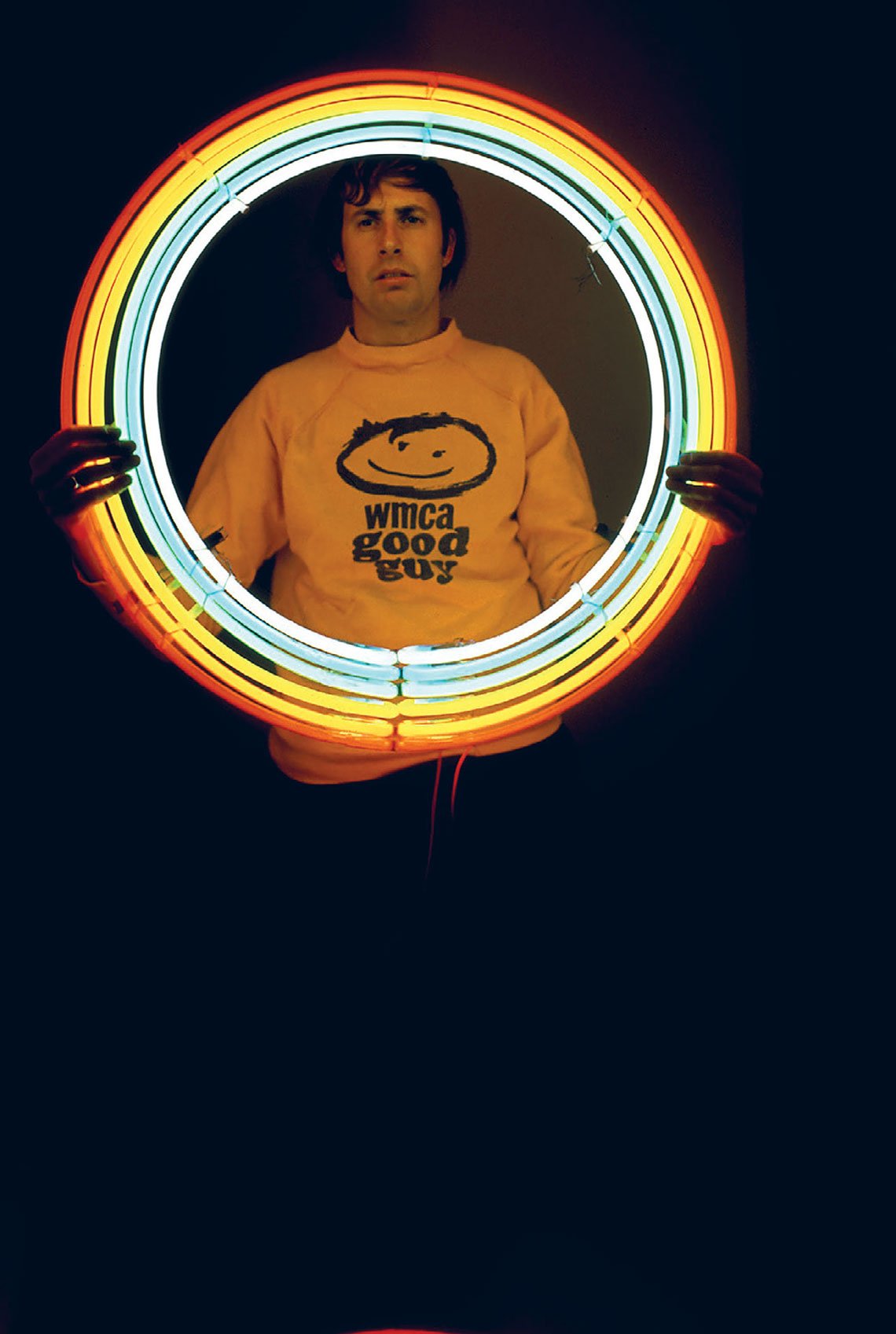Billy Apple®: Rainbows, 1965
 |  | |
| Left: Billy Apple with 360º Rainbow at the Chelsea Hotel, New York, 1965, color transparency, photographer Richard Polson, Billy Apple® Archive. Right: Rainbow Waterfall, 1965. Plexiglass. The Mayor Gallery, London, 2022. | ||
Billy Apple®: Rainbows, 1965
The Mayor Gallery, 21 Cork Street, London through July 27
Branding seems to be such a ubiquitous component of our lives these days it is hard to imagine the very idea of it as radical, even conceptual, or furthermore as a creative gesture. But that’s exactly what Billy Apple (1935–2021) did, transforming himself from a New Zealand born graphic artist living in London in the early 1960s named Barrie Bates into Billy Apple. He became, himself, a registered trademark in 2007.
Apple was a conceptual artist who worked in a Pop idiom — it is odd, today, to think of those two things together but during the 1960s and 1970s they vied for supremacy in the international art world following the end of Abstract Expressionism. Pop won out in the end, dominating the art and museum markets, while conceptual art retreated to the academy where it stayed alive, on life support, propped up by academic salaries.
 |  | |
Left: Rainbow 8, 1964–65. The Mayor Gallery, London, 2022. Right: A for Apple, 1962–63, argon gas with mercury vapour, 15 mm coated yellow glass tubing, cast bronze, 243 × 210 × 150 mm, courtesy of The Mayor Gallery, London | ||
 |
Rainbow Sections, 1965. Serigraphs. Courtesy of Mary Apple and The Mayor Gallery, London (photo: The Mayor Gallery). |
Apple made artworks as what he described as “visual aids to support the name change.” Once, for instance, he cast apples and painted them in automotive paint, red and green. These became the preferred colors for the Billy Apple® brand and persist in his work. He made neon signs shaped in the capital letter A in green, and a variety of paintings and sculptures of apples. Later he even marketed apple cider.
His show at The Mayor Gallery now in London, the first since he passed away in September 2021, titled Rainbows 1965, is a reprise of the exhibition Billy Apple® held at Bianchini Gallery in New York in November 1965 following his permanent relocation from London to New York in late 1964. Rainbows 1965 was one of several ‘light art’ shows he staged and contributed to from 1965 to 1972. He was not the first artist to use neon tubing but his work in this material is highly original.
 |  | |
Rainbow with Waterfall, 1965. Plexiglass. Colour transparency courtesy of Billy Apple® Archive (left), and at The Mayor Gallery, London, 2022 (right). | ||
 |  | |
360º Rainbow, 1964–65. Installed at Bianchini Gallery, New York, 1965. Colour transparency courtesy of Billy Apple® Archive (left), and at The Mayor Gallery, London, 2022 (right). | ||
Rainbows have so much symbolism in our culture — gender diversity, peace protests or anti-war slogans and associations to 1960s counter-culture, or simply innocence as in the decorations for a child’s nursery. The focus in The Mayor Gallery show is rainbows, including three floor-based neon sculptures from the original Bianchini show that remained in the artist’s studio and have not been shown since then.
The rainbow neons are gorgeous, sumptuous, fun, loveable Pop sculptures that take on Minimalism, redefine it as pleasure, but ultimately function as a work of conceptual art commenting on the dreams of consumerism. Hard to imagine that conceptual art could be so beautiful but that was always the way with Apple, years of training in the graphic arts gave him a visual sensibility. He knew what looked good and why.
The rainbow neons are accompanied by Plexiglas sculptures and Apple’s Rainbow serigraph, all of which were included in the 1965 Bianchini exhibition. Together they make this show a fascinating historical time warp — this was contemporary art back in 1965. What is interesting is that the work feels fresh, relevant, prescient, as well as, well, contemporary, like it could have been made this year. It is timeless, in a word, which is what we can and should demand from the very best art of any era. This is it.



























